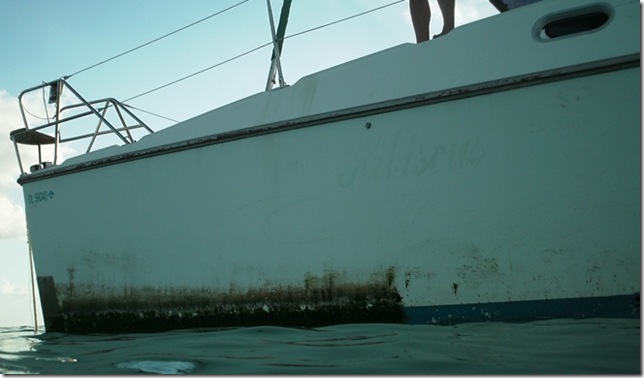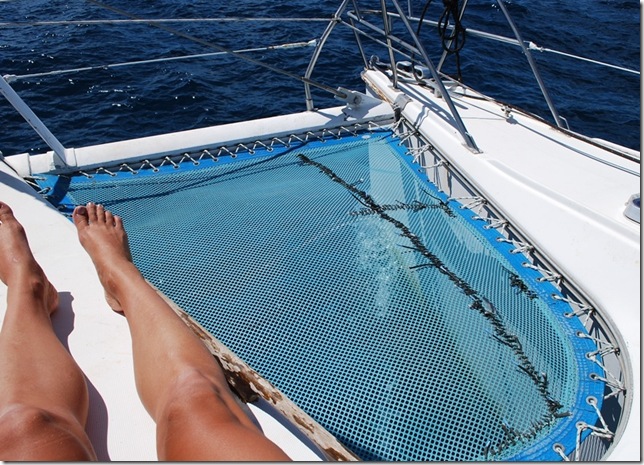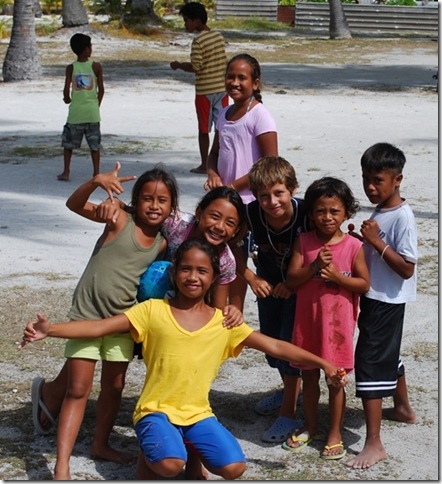We’re leaving for Tahiti this morning. According to the weather forecast, we should expect pretty light winds, so the 250 miles or so could take 3 days. With oil and gasoline at a premium here, we’re trying to limit engine time, so hopefully there will be enough wind to keep the sails set.
With a light wind passage ahead and beautiful lagoon water underneath the boat, Lauren and I decided to do boat work yesterday instead of dive the south pass. Unfortunately, the dive trip was an all-day 2-dive package that was 3 times what it cost us to dive the north pass, so Wes and Tiff decided to pass it up as well. We had gotten up at 6 am to get over to the dive shop, so Lauren and I were in the water pretty early to finish cleaning the bottom of the boat. Since it had not been cleaned since the Galapagos, it had become a pretty big job. We’d already put in several hours work, and it still took both of us working for over 2 hours to finish it off. The algae/weed on the outsides of the hulls, which get more sunlight, looked like green shag carpeting 1-2 inches long! There were plenty of barnacles on the bottoms of the keels and hulls as well. As we scraped the barnacles off, two schools of fish about a foot long swam 10-20 feet below us and munched on the small barnacles that were floating down like confetti. One school of fish was silver with yellow markings and the other was silver with long, thin snouts and well-defined mouths and eyes that really made them look like they had an animal face. We changed the sacrificial zincs on the prop shafts as well (about 4 months old), so hopefully we’ll be OK below the waterline for a while, although in the future I think we’ll opt for lighter and more frequent cleanings instead of waiting so long. Two 12-meter hulls make for a lot of surface area to scrub by hand, especially underwater.
It was interesting to note that the area of the starboard keel that Wes repaired in Key West had virtually no marine growth at all on it. We went with el cheapo $60/gal bottom paint in January but bought a quart of expensive stuff to cover the patched area because it was all we could find in the same color (and fish hate looking at a two-color paint job). It looks like we got what we paid for. The $60/gal stuff is great as long as you don’t keep your boat in the water, let alone the Humboldt current and South Pacific.
We spent the rest of the daylight re-running the main halyard inside the mast, doing laundry, fixing the port navigation light, which had gone out again on our way to Fakarava (more corrosion), and stitching up the starboard tramp again. The starboard tramp now has quite a bit of stitching, but hopefully it will at least get us to New Zealand. Wes also ran a new roller furling line, which had chafed through the outer jacket in several spots and repositioned the high water bilge alarms that had gone off while we were drifting in the swell.
Running a new in-mast halyard turned out to be an adventure. The winning solution ended up being a thin messenger string with several bolts tied one after the other at the end (one large bolt got stuck and one small bolt was too light). After several failed attempts, I was finally able to lower the string down from the top of the mast and fish it out of the tiny hole at the bottom with a coat hanger. Lauren is developing some nice biceps winching me up the stick while I try to figure out how to get the job done. Our main halyard is now about 100′ of 1/2" Sta-set with about 3′ of 1/4" stainless steel wire spliced into the end. The middle of the halyard had chafed badly where it exits the mast and rubs against a turnbuckle, so I tried repairing that spot with waxed twine (used for whipping the ends of lines) and covering the turnbuckle threads with plastic hose and rigging tape. We’ll see how it all works out this time. When I mentioned the halyard problems to Barry in Daniel’s Bay, his response was, "Yeah. After a while you’ll start dropping the sails every day or two to check them." That sounds like a good idea.
The wind has been very light and we’re tucked in close to shore, so things at the top of the mast weren’t near as lively as before. I spotted a sea turtle on my way up the first time. He was swimming right toward the boat, but I think my hollering down to Lauren to point him out scared him, as he disappeared into the turquoise water before he got much closer. I should have take a camera up, because the view of the lagoon, with all the coral heads in the clear water close to shore, was really incredible. Going up the stick is generally more uncomfortable than dangerous, but I always hold on to the shrouds on my way up and have a safety line or tether rigged just in case. Today I was reminded again how important the safety line could be. Because of the halyard work we were doing, I went up on the spinnaker halyard, which is sort of a compromise. The line is in really good shape, but it runs through a block attached to the outside of the mast with a shackle, which adds a couple of failure points I’d prefer to avoid. When I got to the top of the mast, I noticed that the shackle holding the block, which is about 3/8" stainless, was worn almost half of the way through from rubbing against the eye it’s hanging from. The marine environment definitely keeps us busy.
We’ve really enjoyed the sparsely populated Marquesas and Tuamotus. It’s been long enough since we’ve seen a big city that it will be interesting to see how Tahiti feels to us. Even though this is the second largest atoll and village in the Tuamotus, it’s still pretty small by US standards. There are several hotels and tourist businesses due to the large, easily navigable north pass, but there’s still no bank (there is an ATM in the post office, but it’s only open part of the day), bicycles are as common on the one main street as cars, and the colorful "school bus" takes all the kids home at lunchtime. You know you’ve been away from "civilization" for a while when you get excited about the local store accepting a credit card as payment, having cans of Pringles for only $3.75 each, and being "big, and well-stocked, and cheaper" when the entire store would take up less than one supermarket aisle and a box of pancake mix is $10.
It wasn’t unusual in Kauehi for people to come up to us while we were walking around to say hello and ask us where we were from, trying out whatever English they knew. When Lauren, Wes, and Tiff gave a group of kids some candy, they gathered around as a group to compare their "bon bons" and then one turned and yelled "THANK. YOU." with a big smile. Papeete seems large enough that the anonymity and isolation of city life will be the norm, but we’ll see. Jerome on Na Maka told us that contrary to what people say, the people of the Society Islands are friendly as well, but meeting and making a friend "doesn’t take 30 minutes, it takes 2 days." Antoine says the norm is for the interaction with locals to be replaced by meeting all the other cruisers that linger in the Society Islands. We do know from Antoine’s DVD (another gift) that the Society islands will be incredibly beautiful.
Kids in Kauehi




